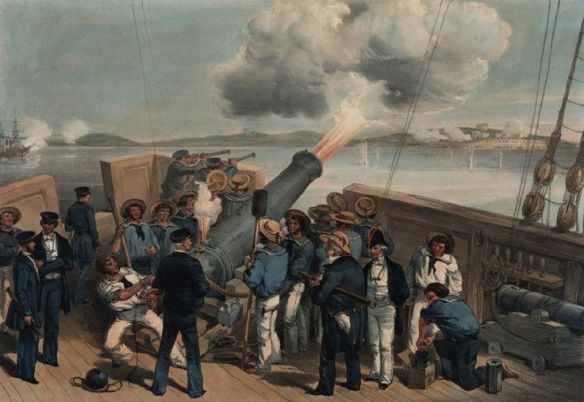British bombardment of the fortress Bomarsund (Aland Islands) during the Crimean war. Drawing from 1854.
HMS Duke of Wellington, Flagship of the Baltic Fleet, which Dundas commanded during the Crimean War
Crimean War, 1854–1856: Baltic Sea Operations
The British and French operations in the Baltic Sea are a frequently overlooked but indispensable component of the overall allied strategy of the Crimean War.
After being invaded by Russia, Turkey declared war on the aggressor on 5 October 1853. To help maintain the Ottoman Empire and preserve the balance of power in Europe, the British and later the French fleets entered the Black Sea to bolster Turkey. A larger war became imminent. In February 1854, British troops sailed for Turkey, with the French deploying forces a few weeks later.
British Vice Admiral Sir Charles Napier was appointed commander of the hastily assembled Baltic Fleet and sailed for the Baltic on 10 March 1854. With British and French expeditionary forces en route to Turkey, Napier’s mission was to seal the Baltic, destroy the Russian fleet, protect Danish and Swedish shipping and territory from Russian attack, and report on the possibilities of attacking fortified Russian ports.
War was declared on 28 March 1854. Napier’s fifteen – ship fleet arrived at the entrance to the Gulf of Finland on 17 April 1854. When the weather improved in May 1854, Napier reconnoitered Russian defenses at Hango and Sveaborg but found them to be too strong for his guns. Leaving ships at Sveaborg, Napier sailed for Kronstadt, arriving on 26 June 1854. Thirty Russian ships were anchored nearby. After a careful reconnaissance, it was determined that only shallow-draught ships could approach the Russian fortress.
Napier sailed back to Sveaborg and received word that about 10,000 French soldiers with ten guns would be sent on British ships to attack either Sveaborg or Bomarsund, the latter guarding the best entrance to the large harbor on Aland. On 8 August 1854, a contingent of Royal Marines and engineers and a French brigade landed north of Bomarsund, and the main French force landed south of it. The forts guarding the harbor entrance were surrounded by the allied force and artillery positioned near it. The allied force began bombarding Bomarsund on 13 August 1854, and it surrendered shortly thereafter. This success, however, achieved very little.
Napier wanted to continue operations, but the French fleet began to withdraw from the Baltic on 4 September 1854. The Royal Navy maintained the blockade on the Russians until the end of October 1854 and then returned to port at Spithead. Napier was abruptly relieved of command, although later vindicated.
In March 1855, Baltic Sea operations recommenced. The British fleet, under the command of Admiral Sir James W. D. Dundas, with a French contingent, detached squadrons to again blockade Russian Baltic ports. Revel, Aland, Hango, Sveaborg, and Kronstadt were reconnoitered by Dundas, who found the defenses of Kronstadt greatly reinforced over the preceding winter months. Dundas believed his naval strength inadequate for attack.
The Royal Navy also operated in the Gulf of Bothnia and at the mouth of the Gulf of Finland to prevent Russian ships from breaking through the blockade. Dundas’s ships also bombarded and destroyed the Russian forts at Svastholm and Frederiksham. Anglo-French vessels began a thunderous bombardment of Sveaborg on 9 August 1855. Two days later Dundas reported that the allies had fired over 1,100 tons of iron shells into Sveaborg, and that the Russian fleet’s naval base had been destroyed. While a British success, the destruction of Sveaborg did little except raise morale at home and expectations that perhaps Sevastopol was equally vulnerable to a continuous allied bombardment.
In November 1855, the fleet withdrew for the winter. The opening of the Paris Peace Conference on 24 February 1856 meant that the Baltic Sea operations were not renewed.
